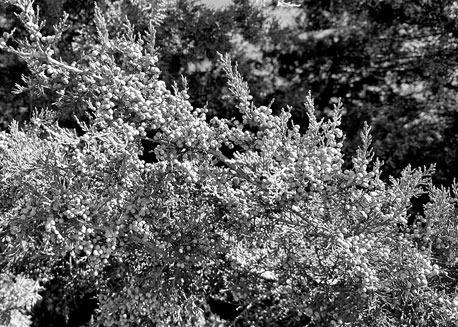Cedar pollen is the likely allergy culprit
Dear Neil: My wife and I are having discussions about whether I should remove a native cedar tree from our landscape. She tests positive for allergies to cedar pollen, and this time of year her miseries begin for a couple of months. She wants me to remove the tree, but we both think it’s very pretty if it weren’t for the pollen. Even its blue berries are attractive, and I notice the birds love them. My contention is that there are dozens of other cedars nearby and that even if I take our one tree out, she will still be hit with the pollen from other trees around us. Do you have any advice?
My wife and I could have written the same letter. We have eastern redcedar junipers on the 11 acres that surround our house. They are starting to turn bronze now, an indication that the pollen is about to fly. We were pretty sure of the cause of her troubles when she visited an older allergist in his last year before retirement. I wrote the name Juniperus virginiana on a piece of paper for her, and she told him she thought that was the culprit. After her tests, he chuckled and said she was the first person who had ever come in with the scientific name of the offending plant written out on a sheet of paper.
She started her nasal spray prescription a couple of weeks ago, just as she has for 15 or 20 years. It makes a huge difference for her. An allergist can prescribe one for your wife. I vote on your side in this case. Juniper pollen, like oak and pecan, is carried hundreds of miles. It starts as South Texas species come into bloom in December and January. Prevailing south winds carry the pollen north to unwitting victims. Even if you were to remove the one plant, there are thousands of others ready to contribute their pollen waiting in the wings. If you’re the one who isn’t allergic, thump one of those bronze branches on a still, dry day with a broom handle and you’ll see the quantities of pollen that’s out there. Let the doctor advise her and prescribe the best remedy. You can’t chop your way out of this forest.
Dear Neil: We had a terrible problem with the nutgrass on our lawn last summer. Will a preemergent weedkiller stop it this year? If so, which one, and when should it be applied?
The weed you have is not a true grass, but a sedge instead. You can always distinguish the sedges from true grasses by rolling the plant’s stem between your thumb and index finger. Grasses will have round stems. Sedges will be triangular. And the other fact you’ll need to remember is that sedges are perennials – they come back from their roots. Pre-emergents only work on annual weeds as their seeds try to germinate. So, if nutsedge is your biggest concern, you would be wasting the preemergent. You’ll want to use either Image or Sedgehammer after the nutsedge is up and growing actively. That’s generally mid-May through mid-September.
Have a question you’d like Neil to consider? E-mail him at mailbag@sperrygardens.com. Neil regrets that he cannot reply to questions individually.




